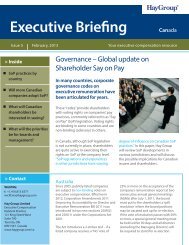Using Competencies to Identify High Performers - Hay Group
Using Competencies to Identify High Performers - Hay Group
Using Competencies to Identify High Performers - Hay Group
Create successful ePaper yourself
Turn your PDF publications into a flip-book with our unique Google optimized e-Paper software.
For example, if the model is <strong>to</strong> be used for selection, then competencies that<br />
are difficult <strong>to</strong> develop can be distinguished from those that can more easily be<br />
developed. An organization will then know <strong>to</strong> take this in<strong>to</strong> account when<br />
assessing and selecting candidates. Selec<strong>to</strong>rs also need <strong>to</strong> be aware of threshold<br />
competencies—those needed <strong>to</strong> achieve average performance—and the differentia<strong>to</strong>r<br />
competencies required <strong>to</strong> achieve outstanding performance.<br />
If an organization intends <strong>to</strong> use the competency models for performance management,<br />
then the competencies might be presented in a way that links them <strong>to</strong><br />
specific deliverables. This powerful method helps people understand how a<br />
lack of a certain competencies impedes their overall performance, which can<br />
then become a focus for development.<br />
Innovative Applications of <strong>Competencies</strong><br />
The approach described above works <strong>to</strong> define competencies for jobs that<br />
already exist in an organization. However, a slight modification is required for<br />
new or rapidly developing roles, or in organizations that simply do not have<br />
many star performers.<br />
The best approach is <strong>to</strong> look for similar jobs elsewhere—if they exist. This does<br />
not have <strong>to</strong> be within the organization for which the competencies are being<br />
defined. It is possible <strong>to</strong> conduct interviews with outstanding performers in<br />
other organizations. In such studies, it is important <strong>to</strong> examine the deeper<br />
competencies such as the motives and the cognitive or thinking patterns of<br />
those in the study, rather than superficial behaviors.<br />
This approach also works when managers do not believe they have star performers<br />
in their own organization. Selecting comparative organizations and jobincumbents<br />
needs <strong>to</strong> be done with great care <strong>to</strong> ensure that the performance<br />
criteria give a good match. This is especially critical because many companies<br />
use similar job titles, but the actual job content and accountabilities might vary<br />
enormously. A vice president of marketing at one company might be responsible<br />
for advertising and media relations, but be accountable for the entire <strong>to</strong>p-line<br />
results at another. It is very important <strong>to</strong> match job content and accountabilities<br />
as opposed <strong>to</strong> job titles.<br />
Organizations that apply<br />
competencies <strong>to</strong> select and<br />
develop individuals for key<br />
roles avoid the collateral<br />
damage associated with a<br />
bad hire.<br />
10<br />
WORKING<br />
PAPER

















